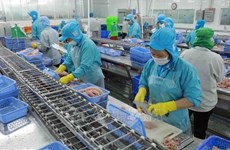VN expects record rice exports despite price drop
Vietnam expects to export a record 6
million tonnes of rice in 2009, despite the anticipated fall in world
rice prices through early next year.
Vietnam expects to export a record 6
million tonnes of rice in 2009, despite the anticipated fall in world
rice prices through early next year.
The country shipped 3.8 million tonnes of rice in the first half of this year, earning 1.8 billion USD, a year-on-year increases of 57 percent and 25 percent in terms of volume and value, respectively.
By the end of June, domestic rice businesses will have contracted to export more than 5 million tonnes of rice, according to the Vietnam Food Association.
Economists forecast a decline in prices on the world rice market late this year and early next year.
Rice prices on the world market soared in mid 2008, then lessened and only lightly increased in the early part of this year, expert Nguyen Dinh Bich from the Trade Research Institute reported at a workshop on prospects for Vietnam ’s rice market in Hanoi on July 21.
Additionally, supply will sharply increase from the rice harvest later this year while demand from importing countries will decrease, forcing rice prices down through early 2010, he said.
However, the expert said that world rice prices depend on elements such as weather, the policies of rice producing countries and oil prices so that a completely accurate forecast is difficult. According to the expert, managers and businessmen should closely watch the world market.
Sharing this view, Nguyen Trang Nhung, an expert from the Rural Development Information Centre, forecast supply on the world rice market will be more abundant due to Vietnam’s bumper crops in late 2009 and a possible increase in sales by the two other rice power houses, Thailand and India. According to the expert, Vietnam ’s rice export price always depends on the world market, so it will follow the trend.
The Philippines is currently Vietnam ’s biggest rice importer, purchasing more than 50 percent of total production. This is followed by Malaysia with 9 percent.
To ensure domestic food security and maintain its place among world leading rice exporters, Vietnam has created a rice growing area of 3.6 million hectares, raised capacity, improved farming technology and the quality of rice strains.
The country shipped 3.8 million tonnes of rice in the first half of this year, earning 1.8 billion USD, a year-on-year increases of 57 percent and 25 percent in terms of volume and value, respectively.
By the end of June, domestic rice businesses will have contracted to export more than 5 million tonnes of rice, according to the Vietnam Food Association.
Economists forecast a decline in prices on the world rice market late this year and early next year.
Rice prices on the world market soared in mid 2008, then lessened and only lightly increased in the early part of this year, expert Nguyen Dinh Bich from the Trade Research Institute reported at a workshop on prospects for Vietnam ’s rice market in Hanoi on July 21.
Additionally, supply will sharply increase from the rice harvest later this year while demand from importing countries will decrease, forcing rice prices down through early 2010, he said.
However, the expert said that world rice prices depend on elements such as weather, the policies of rice producing countries and oil prices so that a completely accurate forecast is difficult. According to the expert, managers and businessmen should closely watch the world market.
Sharing this view, Nguyen Trang Nhung, an expert from the Rural Development Information Centre, forecast supply on the world rice market will be more abundant due to Vietnam’s bumper crops in late 2009 and a possible increase in sales by the two other rice power houses, Thailand and India. According to the expert, Vietnam ’s rice export price always depends on the world market, so it will follow the trend.
The Philippines is currently Vietnam ’s biggest rice importer, purchasing more than 50 percent of total production. This is followed by Malaysia with 9 percent.
To ensure domestic food security and maintain its place among world leading rice exporters, Vietnam has created a rice growing area of 3.6 million hectares, raised capacity, improved farming technology and the quality of rice strains.













